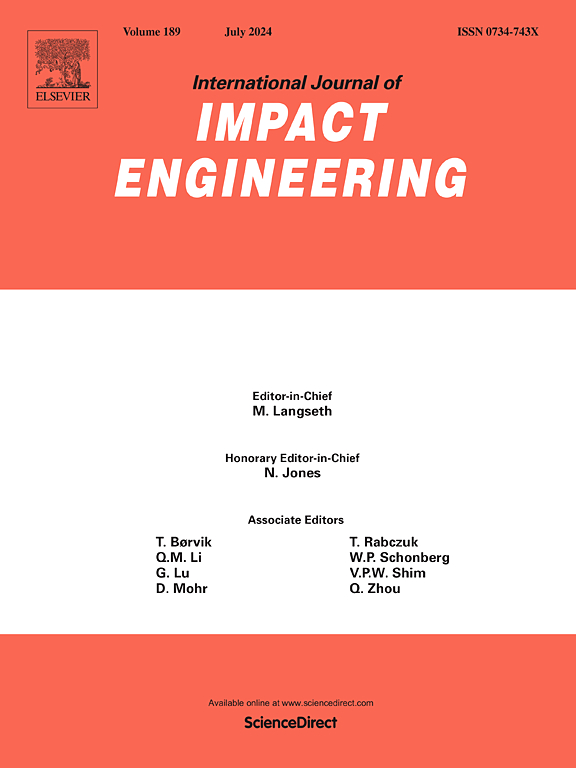Low-velocity impact of a novel CFRP-faced sandwich structure with multi-level negative Poisson's ratio cores
IF 5.1
2区 工程技术
Q1 ENGINEERING, MECHANICAL
International Journal of Impact Engineering
Pub Date : 2025-05-19
DOI:10.1016/j.ijimpeng.2025.105399
引用次数: 0
Abstract
Honeycomb sandwich structures with carbon fiber-reinforced polymer (CFRP) face sheets have found widespread application in aerospace, ship engineering, and automotive industries. This research introduces a novel sandwich structure featuring CFRP face sheets and a multi-level negative Poisson's ratio honeycomb core. Experimental and finite element analysis were conducted to assess the impact resistance of both CFRP laminates and the proposed sandwich structure. A damage model incorporating elastic-plastic behaviour was developed and integrated into the ABAQUS software via VUMAT. Experimental validation confirmed the accuracy of the finite element method (FEM). The study shows that matrix tensile damage is the primary damage mode under low-velocity impacts, with the damage extent and damage pattern being significantly influenced by impactor. Laminate stacking sequences have a minor impact on overall mechanical behaviour but can influence the damage response. Crucially, the honeycomb core configuration significantly enhances energy absorption. For example, the double-arrow multi-level honeycomb structure consisting of only two layers exhibits a 21.4% increase in energy absorption compared to the hexagonal honeycomb structure. These insights offer valuable guidance for optimizing composite structures to achieve superior impact resistance and energy absorption.
多层负泊松比芯层新型cfrp面夹层结构的低速冲击
碳纤维增强聚合物(CFRP)面板的蜂窝夹层结构在航空航天、船舶工程和汽车工业中得到了广泛的应用。本研究介绍了一种新型的碳纤维复合材料面板和多层负泊松比蜂窝芯的夹层结构。通过实验和有限元分析对CFRP复合材料和夹层结构的抗冲击性能进行了评估。建立了结合弹塑性特性的损伤模型,并通过VUMAT将其集成到ABAQUS软件中。实验验证了有限元方法的准确性。研究表明,低速冲击下基体拉伸损伤是主要的损伤模式,冲击器对损伤程度和损伤模式有显著影响。层压板堆叠顺序对整体力学行为影响较小,但会影响损伤响应。至关重要的是,蜂窝核心结构显著提高了能量吸收。例如,仅由两层组成的双箭头多层蜂窝结构的能量吸收比六边形蜂窝结构增加了21.4%。这些见解为优化复合材料结构提供了有价值的指导,以实现卓越的抗冲击性和能量吸收。
本文章由计算机程序翻译,如有差异,请以英文原文为准。
求助全文
约1分钟内获得全文
求助全文
来源期刊

International Journal of Impact Engineering
工程技术-工程:机械
CiteScore
8.70
自引率
13.70%
发文量
241
审稿时长
52 days
期刊介绍:
The International Journal of Impact Engineering, established in 1983 publishes original research findings related to the response of structures, components and materials subjected to impact, blast and high-rate loading. Areas relevant to the journal encompass the following general topics and those associated with them:
-Behaviour and failure of structures and materials under impact and blast loading
-Systems for protection and absorption of impact and blast loading
-Terminal ballistics
-Dynamic behaviour and failure of materials including plasticity and fracture
-Stress waves
-Structural crashworthiness
-High-rate mechanical and forming processes
-Impact, blast and high-rate loading/measurement techniques and their applications
 求助内容:
求助内容: 应助结果提醒方式:
应助结果提醒方式:


